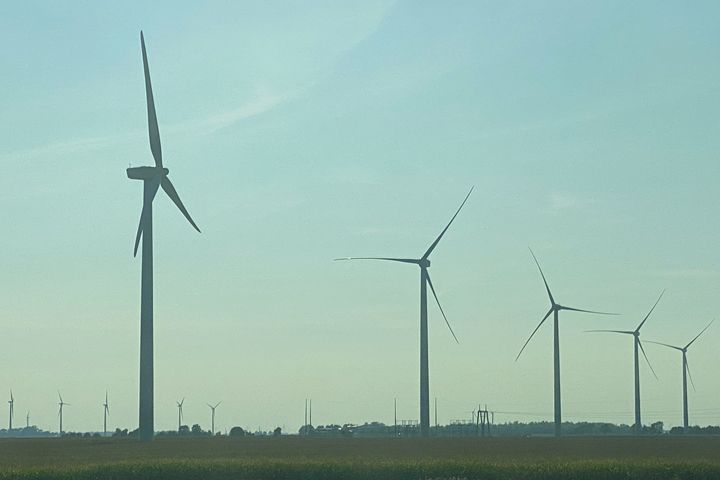Episode 43: Emphasizing the recycling of wind blades
CW Talks discusses Ford Motor Company’s involvement with the EMPHASIZING project, a UK consortium working to develop a material from recycled glass fiber with mechanical properties superior to virgin glass.

The recycling of composite wind blades from wind turbines is a topic of much debate in the composites community and in sustainable energy discussions. In the latest episode of CW Talks, we explore a new approach aimed at the reclaim and upcycling of some of these materials when the wind blade reaches its end of life. Professor Alan Banks, innovation and industrial engagement supervisor at Ford Motor Company’s Dunton Technical Center in the UK, discusses Ford’s involvement with the EMPHASIZING project, a UK consortium working to develop a material from recycled glass fiber with mechanical properties superior to virgin glass, but at a price point lower than carbon fiber.
Read an excerpt from CW Talks Episode 43

Professor Alan Banks, innovation and industrial engagement supervisor for Ford Motor Company’s Dunton Technical Center
Photo Credit: Ford
What are the goals of the EMPHASIZING project?
This whole project kind of started just over a year ago. I was in discussion with senior researcher at the Welding Institute in the UK. We were discussing how we can effectively upcycle glass fiber. The problem with glass fiber at the moment is that it’s probably the most environmentally unfriendly material when it comes to recycling, but it’s also really inexpensive to manufacture as virgin material. So at the moment, there’s no real reason that anyone would want to recycle glass fiber, because it just isn’t commercially viable to do it.
We were thinking about what we could do to improve that and were discussing the sizing of the fibers. It occurred to us that maybe we were all missing a trick that we could size the recycled fiber with something that would give it more of a use in industry, and we thought of graphene — graphene being the strongest material known to man. As I’m sure you know, when you use graphene in a in a matrix, you use a tiny amount. Although graphene is really expensive you can use a tiny amount to to improve the material properties of whatever you want to use it for. So, we figured if we could size the fiber with graphene, then potentially, we would up with a glass fiber that has significantly more mechanical properties than standard glass, fiber, E-glass or X-glass or any of the different glass fibers out there. But because we're making it from recyclate, and we’re using a tiny amount of graphene to size it, then potentially we end up with a material that can be upcycled and that could be relevant to structural components, not just for sort of cosmetic components.
So can you touch on some of the details of of the graphene selection as that that sizing agent? You talked a bit about it broadly, but can you delve into any detail on some of the properties that it it enhances these glass fibers with?
When you put [graphene] in the matrix of carbon fiber (or even glass fiber from from a virgin material) — so not size with graphene, but actually in the matrix — then you improve that you improve the mechanical properties of the end component by a substantial amount. There’s a company called BAC, who make a sports car called the Mono in the UK — they use graphene in the in the resin makeup of of their carbon fiber and it managed to reduce the amount of carbon fiber by about 30% depending on which component they’re using it for.
So when we were thinking about how we could improve glass fiber, obviously, once you’ve got the glass fiber, it’s random. It’s chopped; it has very little commercial value. I think what most people do [to recycle it] at the moment is to put it in concrete to as a as a filler. Which, is recycled and it’s going to be in use for about 100 years — if you put it into concrete and it’s in the building or in some kind of sort of structure, but you don’t really get any commercial benefit out of it.
We really want to improve — and give people a reason to use — recycled glass fiber. I’m sure you’ve seen the pictures of wind blades being buried in fields under mounds of earth. We can’t sustain that. We’ve kind of solved one problem with regard to renewable energy, but we’ve created another with what do we do with the wind blades when they’re decommissioned. At the moment, they’re just being cut up and buried. We’re trying to find a way to fix that.
We felt that the only way to do it was to make the glass fiber commercially viable.
So there’s the selection of graphene, which is part of the project, but we haven’t actually physically done it yet. Currently we’ve got about 100 kilos of recycled glass fiber from a windblade that we’re really happy with. We use a process called “pressolysis” to do that — so we don’t use pyrolysis; we don’t use solvolysis. We work with a company called B&M Longworth — they’ve developed a process which they call thermo cyclic pressolysis, whereby you use superheated steam. So there’s no water content in it, it’s just superheated steam. Once you pressurize it, at about 400 to 500 degrees, and then decompress the cycle, that strips all of the resin and all of the contaminant from the fiber, leaving the fiber completely clean. So it’s effectively a cleaning process rather than a purification process where you burn the resin off — because when you burn the resin off, you actually damaged the fiber and you end up with a fiber with a lower set of mechanical properties than you would have had via the thermo cyclic sort of pressolysis, because the process doesn’t interact with the fiber at all other than stripping all the all of the contaminants off.
So we end up with a fiber that is clean and has the original mechanical properties. And we’re hoping that we can size it with graphene. And then we’re going to make a structural component for vehicle, where we’re going to test it back to back with the steel equivalent. That will allow us to confirm that what we’ve done with the sizing is actually commercially viable.
Can you talk about some of the other opportunities where you see this material possibly being used?
Honestly, it’s gonna depend on where the mechanical properties turn out. That’s kind of phase two of the project, which we’re starting now. Once we’ve managed to size the components with graphene, we’ll understand where the mechanical properties lie. We’re hoping that we end up with a material that is somewhere between glass and carbon fiber in its mechanical properties, but more towards the glass fiber in cost.
I think that was that was the aim of things like basalt fiber, and other fibers that promised a mechanical property somewhere in the middle, and a price point somewhere towards the lower end. From the experience that I’ve had looking at those, they always end up the other way around, they have a they have mechanical properties that are close to glass, but cost that are close to carbon fiber. We are hoping that we can do that entirely the other way around.
And once we have that, and once we clear what that what the mechanical properties are and the price points, then really there’s no reason why you wouldn’t start to use glass in place of carbon in some instances.
From an automotive perspective, there’s physically no reason why you wouldn’t make any component out of it, as long as its mechanical properties are physically able to do it. Fenders, hood panels and tailgate panels — there’s no reason why you wouldn’t use it for those kinds of things. In a crash situation, they’re going to be a lot stronger than the traditional glass fiber.
The graphene should add significant strength to the fiber, then we can explore using graphene enhanced glass fiber as part of structural components for a vehicle, which is why we’ve chosen a suspension component from the Ford Fusion, to look at how we can compare that to the steel part.
And if we can get really good results on that, then there's no reason why that material couldn’t be used for structural suspension parts — side rails, rocker panels and things like that.
Related Content
Recycling end-of-life composite parts: New methods, markets
From infrastructure solutions to consumer products, Polish recycler Anmet and Netherlands-based researchers are developing new methods for repurposing wind turbine blades and other composite parts.
Read MoreBio-based acrylonitrile for carbon fiber manufacture
The quest for a sustainable source of acrylonitrile for carbon fiber manufacture has made the leap from the lab to the market.
Read MorePlant tour: Daher Shap’in TechCenter and composites production plant, Saint-Aignan-de-Grandlieu, France
Co-located R&D and production advance OOA thermosets, thermoplastics, welding, recycling and digital technologies for faster processing and certification of lighter, more sustainable composites.
Read MoreMicrowave heating for more sustainable carbon fiber
Skeptics say it won’t work — Osaka-based Microwave Chemical Co. says it already has — and continues to advance its simulation-based technology to slash energy use and emissions in manufacturing.
Read MoreRead Next
“Structured air” TPS safeguards composite structures
Powered by an 85% air/15% pure polyimide aerogel, Blueshift’s novel material system protects structures during transient thermal events from -200°C to beyond 2400°C for rockets, battery boxes and more.
Read MoreAll-recycled, needle-punched nonwoven CFRP slashes carbon footprint of Formula 2 seat
Dallara and Tenowo collaborate to produce a race-ready Formula 2 seat using recycled carbon fiber, reducing CO2 emissions by 97.5% compared to virgin materials.
Read MoreVIDEO: High-volume processing for fiberglass components
Cannon Ergos, a company specializing in high-ton presses and equipment for composites fabrication and plastics processing, displayed automotive and industrial components at CAMX 2024.
Read More





























